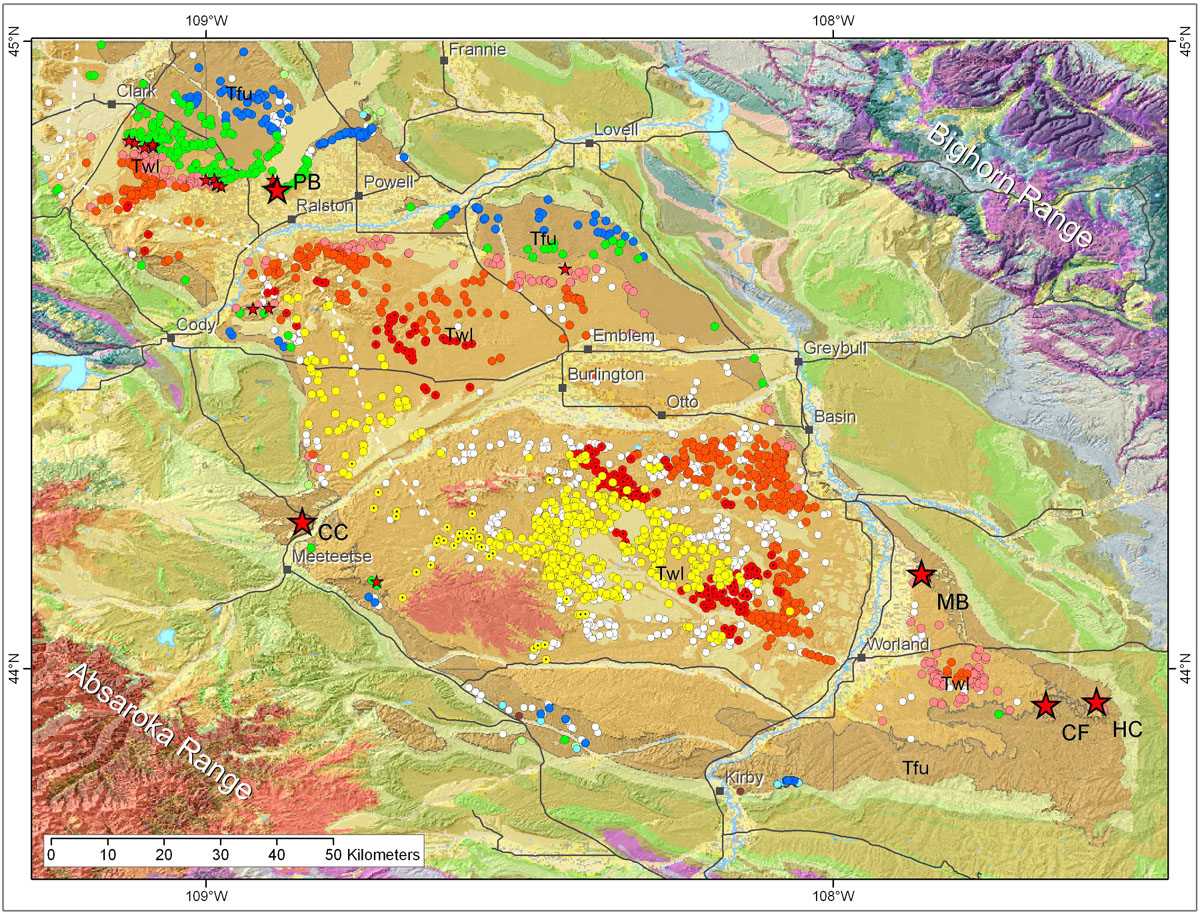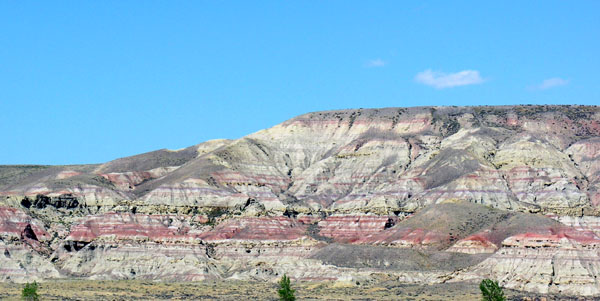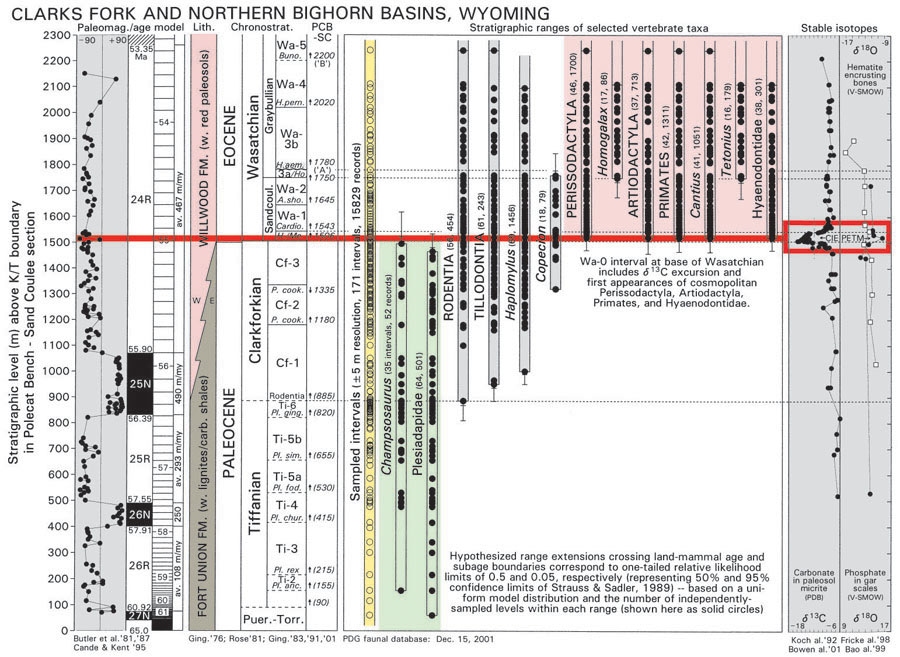The Paleocene epoch of geological time is the first epoch of the Cenozoic 'age of mammals.' Originally part of the
Eocene, it was separated because of its distinctively more primitive flora and vertebrate fauna. Now, in a
nutshell, the Paleocene represents the time between the extinction of dinosaurs and the first
appearance of horses. For vertebrate paleontologists, the appearance of horses
(order Perissodactyla) has long been taken to define the beginning of the Eocene. The
Paleocene-Eocene transition is important for more than horses— many of the modern
orders of mammals make their first appearance in the fossil record at this boundary.
My research on the Paleocene-Eocene boundary and the Paleocene-Eocene
evolutionary transition started in the 1970s when I started as a professor at the University of Michigan. In broadest terms, my objective was to understand the origin of modern orders of
mammals. I was especially interested in modern Primates on one hand, and Perissodactyla on the other, and
I thought that more detailed documentation of the biostratigraphy of mammals crossing the
Paleocene-Eocene boundary might clarify both the origin of primates and the origin of perissodactyls. The first
step was to recollect and restudy the latest-Paleocene Clarkforkian land-mammal age in its
type area, the Clarks Fork Basin of northwestern Wyoming (green localities in the northwestern part of Fig. 1). The Clarkforkian fauna was the
subject of Kenneth Rose's Ph.D. dissertation at Michigan
(Rose, 1981: 11-Mb pdf)
.
In the process of making the
new collections required for the Clarkforkian study, we were able to map a narrow interval
of strata that contained the earliest North American horses (Hyracotherium sandrae, named for
graduate student Sandra Carlson who found a partial skeleton of this species); the earliest
North American primates (Cantius torresi and Teilhardina brandti, named for
graduate students Victor Torres and Carrie Brandt who found the type specimens of
each species); and the earliest North American artiodactyl (Diacodexis ilicis,
named for graduate student Holly Smith who found the type specimen of this). I summarized
what was known at the time about earliest Eocene mammals of the Bighorn and Clarks Fork basins
of northwestern Wyoming in a monograph on what I called the 'Wasatchian zone zero' or Wa-0
mammal fauna
(Gingerich, 1989: 9-Mb pdf).
The richest locality was University of Michigan locality SC-67
at the south end of Polecat Bench, on the divide between the contiguous Clarks Fork and Bighorn basins.
The Wa-0 monograph showed that: (1) Wa-0 mammals are found in a narrow 30 meter-thick
stratigraphic interval that has unusually mature red paleosols (30 m out of ca. 2200 m of upper Paleocene and lower Eocene section); (2) the first North American
artiodactyls, perissodactyls, primates, and hyaenodontid creodonts (so-called APP or
APPH taxa) made their first appearance together in this narrow interval; (3) the Wa-0 fauna included the first APPH
taxa, but overall it was intermediate in proportional representation of taxa between older Clarkforkian and younger
Wasatchian faunas; and, finally, (4) the fauna included several species smaller than older and
younger congeners that are seemingly dwarfed by comparison. Ectocion parvus, named by Granger in 1915 for a specimen found at Polecat Bench, is the
best documented example of dwarfing in the Wa-0 interval.
The 1989 Wa-0 monograph raised many questions: (1) why is the interval so red? (2) why
do the new taxa all come in together at this particular time? (3) why are faunal proportions
intermediate if one fauna replaced another? and (4) why are some species seemingly
dwarfed in this interval? These questions were on the table with no clear prospect
for answers.
Progress came faster than expected when former graduate student Paul Koch made a
survey of carbon and oxygen isotopic ratios through the late Paleocene and early Eocene
on Polecat Bench, and found anomalously light carbon in the Wa-0 interval at locality
SC-67
(Koch et al., 1992).
This isotopic anomaly meant something right away because it was in the interval
with the anomalous Wa-0 fauna. James C. Zachos was a postdoctoral fellow at Michigan
at the time and quickly made the connection to a light δ13C anomaly
described by
Lowell Stott et al. (1990).
Thus very quickly the Paleocene-Eocene boundary on land was tied to the
Paleocene-Eocene boundary in the world's oceans, and biotic events at
the boundary could be tied to what came to be known as the Paleocene-Eocene
Thermal Maximum or 'PETM.' The PETM is recognized around the world by its
negative δ13C carbon isotope excursion or 'CIE' signature.
High-resolution CIE shown in red in Figure 3 is from
(Bowen et al., 2001).
Ongoing Paleocene-Eocene transition research at Polecat Bench and elsewhere in the Bighorn Basin is summarized in the following publications.
Gingerich, P. D. 1976. Cranial anatomy and evolution of early Tertiary Plesiadapidae (Mammalia, Primates). University of Michigan Papers on Paleontology, 15: 1-140. PDF (Deep Blue) or Request PDF/reprint 32
Butler, R. F., P. D. Gingerich, and E. H. Lindsay. 1981. Magnetic polarity stratigraphy and biostratigraphy of Paleocene and lower Eocene continental deposits, Clarks Fork Basin, Wyoming. Journal of Geology, 89: 299-316. PDF or Request PDF/reprint 101
Gingerich, P. D. 1983. Paleocene-Eocene faunal zones and a preliminary analysis of Laramide structural deformation in the Clarks Fork Basin, Wyoming. Wyoming Geological Association Guidebook, 34: 185-195. PDF or Request PDF/reprint 135
Gingerich, P. D. and K. Klitz. 1985. Paleocene and early Eocene fossil localities in the Fort Union and Willwood Formations, Clarks Fork Basin, Wyoming. University of Michigan Museum of Paleontology, Miscellaneous Contributions, 1 sheet (map). PDF (Deep Blue) or Request PDF/reprint 170
Gingerich, P. D. 1989. New earliest Wasatchian mammalian fauna from the Eocene of northwestern Wyoming: composition and diversity in a rarely sampled high-floodplain assemblage. University of Michigan Papers on Paleontology, 28: 1-97. PDF (Deep Blue) or Request PDF/reprint 208
Rea, D. K., J. C. Zachos, R. M. Owen, and P. D. Gingerich. 1990. Global change at the Paleocene-Eocene boundary: climatic and evolutionary consequences of tectonic events. Palaeogeography, Palaeoclimatology, Palaeoecology, 79: 117-128. PDF (Deep Blue) or Request PDF/reprint 214
Gingerich, P. D. 1991. Systematics and evolution of early Eocene Perissodactyla (Mammalia) in the Clarks Fork Basin, Wyoming. Contributions from the Museum of Paleontology, University of Michigan, 28: 181-213. PDF (Deep Blue) or Request PDF/reprint 227
Koch, P. L., J. C. Zachos, and P. D. Gingerich. 1992. Correlation between isotope records in marine and continental carbon reservoirs near the Palaeocene-Eocene boundary. Nature, 358: 319-322. Online or Request PDF/reprint 244
Clyde, W. C., J. Stamatakos, and P. D. Gingerich. 1994. Chronology of the Wasatchian land-mammal age (early Eocene): magnetostratigraphic results from the McCullough Peaks section, northern Bighorn Basin, Wyoming. Journal of Geology, 102: 367-377. PDF or Request PDF/reprint 276
Fricke, H. C., W. C. Clyde, J. R. O'Neil, and P. D. Gingerich. 1998. Evidence for rapid climate change in North America during the latest Paleocene thermal maximum: oxygen isotope compositions of biogenic phosphate from the Bighorn Basin (Wyoming). Earth and Planetary Science Letters, 160: 193-208. Online or Request PDF/reprint 333
Clyde, W. C. and P. D. Gingerich. 1998. Mammalian community response to the latest Paleocene thermal maximum: an isotaphonomic study in the northern Bighorn Basin, Wyoming. Geology, 26: 1011-1014. Online or Request PDF/reprint 342
Gingerich, P. D. (ed.). 2001. Paleocene-Eocene Stratigraphy and Biotic Change in the Bighorn and Clarks Fork Basins, Wyoming, University of Michigan Papers on Paleontology, 1-198 pp. PDF (28 MB; Deep Blue) or Request PDF/reprint 370
Gingerich, P. D. and W. C. Clyde. 2001. Overview of mammalian biostratigraphy in the Paleocene-Eocene Fort Union and Willwood formations of the Bighorn and Clarks Fork basins. In P. D. Gingerich (ed.), Paleocene-Eocene stratigraphy and biotic change in the Bighorn and Clarks Fork basins, Wyoming, University of Michigan Papers on Paleontology, 33: 1-14. PDF or Request PDF/reprint 371
Gingerich, P. D. 2001. Biostratigraphy of the continental Paleocene-Eocene boundary interval on Polecat Bench in the northern Bighorn Basin. In P. D. Gingerich (ed.), Paleocene-Eocene stratigraphy and biotic change in the Bighorn and Clarks Fork basins, Wyoming, University of Michigan Papers on Paleontology, 33: 37-71. PDF or Request PDF/reprint 372
Bowen, G. J., P. L. Koch, P. D. Gingerich, R. D. Norris, S. Bains, and R. M. Corfield. 2001. Refined isotope stratigraphy across the continental Paleocene-Eocene boundary on Polecat Bench in the northern Bighorn Basin. In P. D. Gingerich (ed.), Paleocene-Eocene stratigraphy and biotic change in the Bighorn and Clarks Fork basins, Wyoming, University of Michigan Papers on Paleontology, 33: 73-88. PDF or Request PDF/reprint 373
Wing, S. L., P. D. Gingerich, B. Schmitz, and E. Thomas (eds.). 2003. Causes and consequences of globally warm climates in the early Paleogene, Geological Society of America, Special Papers, 1-614 pp. Order book
Bains, S., R. D. Norris, R. M. Corfield, G. J. Bowen, P. D. Gingerich, and P. L. Koch. 2003. Marine-terrestrial linkages at the Paleocene-Eocene boundary. In S. L. Wing, P. D. Gingerich, E. Thomas, and B. Schmitz (eds.), Causes and consequences of globally warm climates in the early Paleogene, Geological Society of America, Special Papers, 369: 1-9. PDF or Request PDF/reprint 401
Gingerich, P. D. 2003. Mammalian responses to climate change at the Paleocene-Eocene boundary: Polecat Bench record in the northern Bighorn Basin, Wyoming. In S. L. Wing, P. D. Gingerich, B. Schmitz, and E. Thomas (eds.), Causes and consequences of globally warm climates in the early Paleogene, Geological Society of America, Special Papers, 369: 463-478. PDF or Request PDF/reprint 402
Lofgren, D. L., J. A. Lillegraven, W. A. Clemens, P. D. Gingerich, and T. E. Williamson. 2004. Paleocene biochronology: the Puercan through Clarkforkian land-mammal ages. In M. O. Woodburne (ed.), Late Cretaceous and Cenozoic mammals of North America, Columbia University Press, New York, pp. 43-105. Order book or Request PDF/reprint 417
Magioncalda, R., C. Dupuis, T. Smith, E. Steurbaut, and P. D. Gingerich. 2004. Paleocene-Eocene carbon isotope excursions in organic carbon and pedogenic carbonate: direct comparison in a continental stratigraphic section. Geology, 32: 553-556. Online or Request PDF/reprint 418
Gingerich, P. D. 2004. Paleocene-Eocene epoch boundary: closure on a century of disagreement. Geoscience News, University of Michigan, Spring 2004: 19. PDF or Request PDF/reprint 419
Gingerich, P. D. 2004. Paleogene vertebrates and their response to environmental change. Neues Jahrbuch für Geologie und Paläontologie, Abhandlungen, Stuttgart, 234: 1-23. PDF or Request PDF/reprint 430
Gingerich, P. D. 2006. Environment and evolution through the Paleocene-Eocene thermal maximum. Trends in Ecology and Evolution, 21: 246-253. Online or Request PDF/reprint 441
Secord, R., P. D. Gingerich, M. E. Smith, W. C. Clyde, P. Wilf, and B. S. Singer. 2006. Geochronology and mammalian biostratigraphy of middle and upper Paleocene continental strata, Bighorn Basin, Wyoming. American Journal of Science, 306: 211-245. Online or Request PDF/reprint 447
Smith, T., K. D. Rose, and P. D. Gingerich. 2006. Rapid Asia-Europe-North America dispersal of the earliest Eocene primate Teilhardina. Proceedings of the National Academy of Sciences USA, 103: 11223-11227. Online or Request PDF/reprint 448
Gingerich, P. D. and T. Smith. 2006. Paleocene-Eocene land mammals from three new latest Clarkforkian and earliest Wasatchian wash sites at Polecat Bench in the northern Bighorn Basin, Wyoming. Contributions from the Museum of Paleontology, University of Michigan, 31: 245-303. PDF (Deep Blue) or Request PDF/reprint 456
Yans, J., S. G. Strait, T. Smith, C. Dupuis, E. Steurbaut, and P. D. Gingerich. 2006. High-resolution carbon isotope stratigraphy and mammalian faunal change at the Paleocene-Eocene boundary in the Honeycombs area of the southern Bighorn Basin, Wyoming. American Journal of Science, 306: 712-735. Online or Request PDF/reprint 457
Gingerich, P. D. 2007. Paleocene-Eocene transition: Polecat Bench. Privately printed, White Ink, Powell, Wyoming, 4 pp. PDF or Request PDF/reprint 459
Aubry, M.-P., K. Ouda, C. Dupuis, W. A. Berggren, J. A. Van Couvering, J. R. Ali, H. Brinkhuis, P. D. Gingerich, C. Heilmann-Clausen, J. J. Hooker, D. V. Kent, C. King , R. W. O. Knox, P. Laga, E. Molina, E. Steurbaut, and D. J. Ward. 2007. The global standard stratotype-section and point (GSSP) for the base of the Eocene series in the Dababiya section (Egypt). Episodes, 4: 271-286. PDF or Request PDF/reprint 474
Wood, A. R., M. J. Kraus, and P. D. Gingerich. 2008. Down-slope fossil contamination: mammal-bearing fluvial congolomerates and the Paleocene-Eocene faunal transition (Willwood Formation, Bighorn Basin, Wyoming). Palaios, 23: 380-390. Online or Request PDF/reprint 476
Abdul Aziz, H., F. J. Hilgen, Luijk Gerson M. van, A. Sluijs, M. J. Kraus, J. M. Pares, and P. D. Gingerich. 2008. Astronomical climate control on paleosol stacking patterns in the upper Paleocene--lower Eocene Willwood Formation (Bighorn Basin, Wyoming). Geology, 36: 531-534. Online or Request PDF/reprint 478
Secord, R., P. D. Gingerich, K. C. Lohmann, and K. G. MacLeod. 2010. Continental warming preceding the Paleocene-Eocene thermal maximum. Nature, 467: 955-958. PDF or Request PDF/reprint 517
Gingerich, P. D. 2010. Mammalian faunal succession through the Paleocene-Eocene thermal maximum (PETM) in western North America. Vertebrata PalAsiatica, Beijing, 48: 308-327. PDF or Request PDF/reprint 518
Other
Bloch, J. I. 2001. Mammalian paleontology of freshwater limestones from the Paleocene-Eocene of the Clarks Fork Basin, Wyoming. Ph.D. dissertation, University of Michigan, Ann Arbor, 358.
Bowen, G. J., T. J. Bralower, M. L. Delaney, G. R. Dickens, D. C. Kelly, P. L. Koch, L. R. Kump, J. Meng, L. C. Sloan, E. Thomas, S. L. Wing, and J. C. Zachos. 2006. Eocene hyperthermal event offers insight into greenhouse warming. EOS, Transactions of the American Geophysical Union, 87: 165-169. Online
Clyde, W. C. 1997. Stratigraphy and mammalian paleontology of the McCullough Peaks, northern Bighorn Basin, Wyoming: implications for biochronology, basin development, and community reorganization across the Paleocene-Eocene boundary. Ph.D. dissertation, University of Michigan, Ann Arbor, 270.
Clyde, W. C., J. A. Finarelli, and K. E. Christensen. 2005. Evaluating the relationship between pedofacies and faunal composition: implications for faunal turnover at the Paleocene-Eocene boundary. Palaios, 20: 390-399. Online
Gunnell, G. F. 1998. Mammalian faunal composition and the Paleocene-Eocene epoch/series boundary: evidence from the northern Bighorn Basin, Wyoming. In M.-P. Aubry, S. G. Lucas, and W. A. Berggren (eds.), Late Paleocene-early Eocene climatic and biotic events in the marine and terrestrial records, Columbia University Press, New York, pp. 409-427.
Harrington, G. J., E. R. Clechenko, and D. Clay Kelly. 2005. Palynology and organic-carbon isotope ratios across a terrestrial Palaeocene/Eocene boundary section in the Williston Basin, North Dakota, USA. Palaeogeography, Palaeoclimatology, Palaeoecology, 226: 214-232. Online
Hartman, J. H. and B. Roth. 1998. Late Paleocene and early Eocene nonmarine molluscan faunal change in the Bighorn Basin, northwestern Wyoming and south-central Montana. In M.-P. Aubry, S. G. Lucas, and W. A. Berggren (eds.), Late Paleocene-early Eocene climatic and biotic events in the marine and terrestrial records, Columbia University Press, New York, pp. 323-379.
Kraus, M. J. and S. Riggins. 2006. Transient drying during the Paleocene-Eocene Thermal Maximum (PETM): analysis of paleosols in the bighorn basin, Wyoming . Palaeogeography, Palaeoclimatology, Palaeoecology, in press. Online
Secord, R. 2008. The Tiffanian Land-Mammal Age (middle and late Paleocene) in the northern Bighorn Basin, Wyoming. University of Michigan Papers on Paleontology, 35: 1-192. PDF (Deep Blue: 62 Mb)
Strait, S. G. 2001. New Wa-0 mammalian fauna from Castle Gardens in the southeastern Bighorn Basin. In P. D. Gingerich (ed.), Paleocene-Eocene stratigraphy and biotic change in the Bighorn and Clarks Fork basins, Wyoming, University of Michigan Papers on Paleontology, 33: 127-143.
Wing, S. L., G. J. Harrington, F. A. Smith, J. I. Bloch, D. M. Boyer, and K. H. Freeman. 2005. Transient floral change and rapid global warming at the Paleocene-Eocene boundary. Science, 310: 993-996. Online




